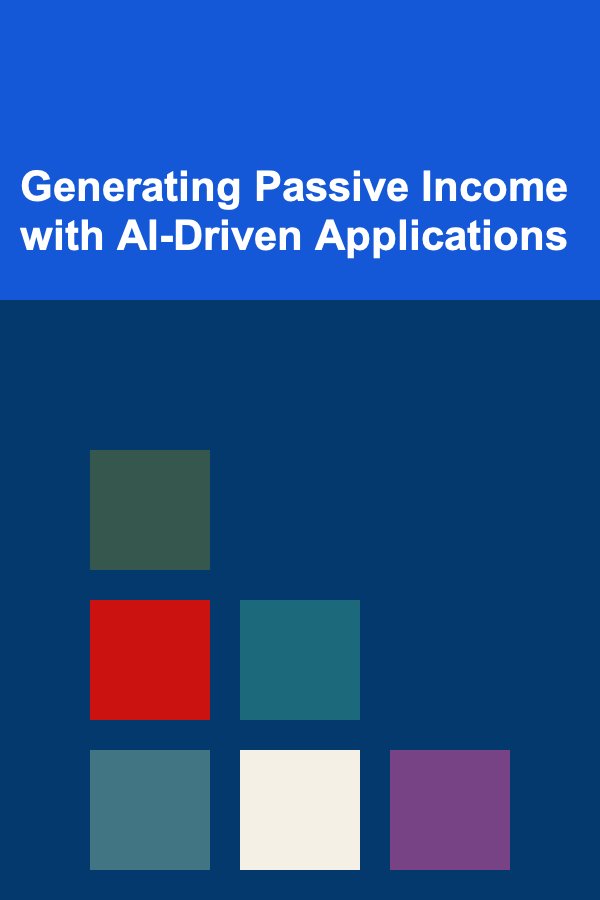
Generating Passive Income with AI-Driven Applications
ebook include PDF & Audio bundle (Micro Guide)
$12.99$11.99
Limited Time Offer! Order within the next:

In the evolving digital landscape, artificial intelligence (AI) has emerged as a transformative force, reshaping industries, augmenting business models, and opening up new possibilities for individuals to generate passive income. From AI-powered apps and platforms to intelligent automation systems, the potential of AI to provide sustainable revenue streams has never been more apparent. In this comprehensive guide, we will explore how AI-driven applications can be harnessed to generate passive income, the opportunities they offer, and how you can leverage this technology to build long-term wealth with minimal active involvement.
Understanding Passive Income
Before diving into AI-driven applications, it's important to clarify what passive income entails. Passive income refers to earnings derived from investments or business activities that require little to no ongoing effort to maintain. Unlike active income, where time and effort are exchanged directly for money (such as a salary or hourly wage), passive income involves setting up systems or assets that continue to generate revenue over time with minimal involvement.
Traditional forms of passive income include real estate investments, dividend-paying stocks, or royalties from creative work. However, with the rise of AI, new opportunities have emerged in the digital realm, enabling individuals to create AI-driven businesses that generate income without the need for continuous hands-on work.
How AI Can Help Generate Passive Income
AI, particularly machine learning and deep learning technologies, allows for the creation of systems that can learn from data, make decisions, and optimize operations with little human intervention. By developing AI-driven applications, individuals can automate business processes, create products or services that operate autonomously, and build revenue-generating systems that run continuously.
AI-driven applications that generate passive income typically follow a model where they require significant upfront development or setup but can then be automated, requiring little maintenance afterward. The primary strength of AI in this context lies in its ability to scale, optimize, and operate 24/7 without the need for constant supervision.
Let's explore some of the most popular ways AI-driven applications can be used to generate passive income.
AI-Powered SaaS Products
One of the most popular avenues for passive income in the digital world is Software-as-a-Service (SaaS). SaaS products are cloud-based applications that users subscribe to on a monthly or annual basis. These products often solve specific business or personal needs, such as project management, accounting, or customer relationship management.
AI has become a game-changer in the SaaS space, allowing for the development of highly intelligent applications that can automate tasks, provide data insights, and make smart recommendations. AI-powered SaaS products have the potential to generate continuous passive income by attracting a wide range of users who pay for access to these tools.
Example: AI-Powered Content Generation Tools
One of the most successful applications of AI in SaaS is content generation. AI tools that automate content creation---such as blog posts, social media updates, or product descriptions---have become highly popular. Platforms like Copy.ai and Jasper use machine learning models to generate human-like text, saving businesses and content creators significant time and effort.
By developing a similar tool, you could create a SaaS product that helps users generate high-quality content. After developing the AI model and setting up the platform, you could offer the tool on a subscription basis, creating a stream of passive income as businesses and individuals continue to use it.
Benefits of AI-Powered SaaS:
- Scalability: Once the application is developed, scaling it to serve more customers requires minimal effort.
- Automation: The AI-powered SaaS platform can run on its own, with minimal intervention required for updates or customer support.
- Recurring Revenue: By offering subscription-based pricing models, you can create a steady stream of income that grows as you acquire more customers.
AI Chatbots for Customer Service and Lead Generation
Another lucrative opportunity in the AI-driven passive income space is the development of intelligent chatbots for customer service and lead generation. These AI-powered tools are increasingly being used across industries to provide 24/7 customer support, answer frequently asked questions, and even qualify leads for sales teams.
AI chatbots, particularly those powered by natural language processing (NLP), are capable of understanding and responding to customer inquiries in real-time. Once developed and deployed on a website or platform, these chatbots can automate significant portions of customer interaction, reducing the need for human involvement.
Example: AI-Powered Chatbot for E-Commerce Websites
An AI-powered chatbot for e-commerce websites can engage with customers, assist them in finding products, and even complete transactions. By integrating the chatbot with the website's backend system, it can handle multiple customers simultaneously, respond to inquiries about inventory, and provide personalized product recommendations based on user preferences.
After developing the chatbot and deploying it to e-commerce stores, you could monetize the service by charging businesses a subscription fee to use the chatbot or a performance-based fee tied to sales generated through the chatbot.
Benefits of AI-Powered Chatbots:
- 24/7 Availability: Chatbots can engage with customers around the clock, ensuring that businesses never miss out on potential sales or support opportunities.
- Efficiency: AI chatbots can handle multiple customers at once, significantly improving efficiency compared to human agents.
- Scalability: Once set up, AI chatbots can serve an unlimited number of customers without requiring additional resources.
AI-Driven Digital Products: Courses, E-books, and Content
AI-powered applications are not limited to business-to-business (B2B) products. They can also be applied to the digital products market, where individuals can generate passive income by selling e-books, courses, or other digital content powered by AI.
For example, if you have expertise in a particular field, you could create an AI-based course that teaches others how to use AI tools in their own work. You could then sell this course online, earning passive income each time someone enrolls.
Example: AI Course Creation with Personalized Learning Paths
AI can be used to create personalized learning experiences in online courses. For instance, AI-driven platforms can assess a student's learning style, pace, and strengths, and automatically adjust the content delivery accordingly. After creating an AI-powered course, you can sell it on platforms like Udemy or Teachable.
Once the course is created, you don't need to actively engage with students, as the platform will handle enrollments, payments, and student communications. You simply collect revenue from the sales and continue to improve the course periodically.
Benefits of AI-Driven Digital Products:
- Automated Content Delivery: Once the product is developed, the system can automatically deliver content to customers.
- Global Reach: Digital products can be sold to a global audience without geographic limitations.
- Low Overhead: The cost of producing and distributing digital products is minimal, allowing for high profit margins.
AI in Financial Markets: Automated Trading and Investment Strategies
AI-driven applications are also gaining popularity in the financial sector, particularly for automated trading and investment strategies. AI-powered algorithms can analyze large volumes of market data, identify patterns, and make trades based on predefined criteria, without human intervention.
Example: AI-Powered Stock Trading Bot
AI trading bots use deep learning and machine learning models to predict stock price movements and make buy/sell decisions. After initial setup, these bots can operate continuously, executing trades automatically based on real-time market conditions. By setting up an AI trading bot and integrating it with platforms like MetaTrader or Alpaca, you could generate passive income by earning a share of the profits from successful trades.
Benefits of AI-Powered Trading Bots:
- Continuous Operation: AI trading bots can work 24/7, taking advantage of market opportunities even when you're not actively monitoring the markets.
- Data-Driven Decisions: AI bots make decisions based on data, reducing the emotional bias often associated with manual trading.
- Scalability: AI systems can analyze vast amounts of data and execute thousands of trades per day, offering scalability that human traders cannot match.
AI-Based Content Monetization: YouTube and Social Media Automation
AI can also be used to automate content creation for platforms like YouTube, Instagram, or TikTok, enabling content creators to generate passive income through ad revenue, affiliate marketing, or brand sponsorships.
For instance, AI tools can be used to automatically generate video scripts, edit videos, and even create voiceovers using text-to-speech models. After developing a content creation pipeline powered by AI, you can upload videos to YouTube, where they will continue to generate revenue over time as long as they attract views.
Example: AI-Powered Video Production for YouTube
Using deep learning models, you can create AI tools that generate video scripts, voiceovers, and automated editing based on trending topics. Once the video is uploaded, it can continue to earn money through YouTube ad revenue without further involvement.
Benefits of AI-Powered Content Monetization:
- Automated Production: AI tools can automate the entire video creation process, from scripting to editing.
- Monetization Opportunities: Once videos are uploaded, they can generate ongoing income through ads and sponsorships.
- Scalability: AI can quickly scale up video production to cover multiple topics, creating opportunities for larger audiences.
Conclusion
AI-driven applications offer a powerful means of generating passive income, with applications spanning a wide range of industries from SaaS and e-commerce to financial trading and content creation. The key to success lies in creating systems or products that operate autonomously, leveraging AI's ability to scale and optimize processes with minimal human intervention.
While setting up AI-driven income streams may require an initial investment of time, effort, and expertise, the long-term rewards can be substantial. Once established, these systems can provide a continuous flow of revenue, allowing you to reap the benefits of your work with minimal ongoing effort.
As AI technology continues to advance, the opportunities for generating passive income through AI-driven applications will only expand. By staying ahead of the curve and leveraging these powerful tools, you can build a sustainable and scalable source of passive income in the digital age.
Reading More From Our Other Websites
- [Needle Felting Tip 101] From Thread to Canvas: How to Capture Perfect Needle-Felted Pictures
- [Home Staging 101] How to Stage a Home for First-Time Buyers
- [Organization Tip 101] How to Implement a Color-Coding System for Supplies
- [Home Maintenance 101] How to Successfully Winterize Your Home for Maximum Energy Efficiency
- [Paragliding Tip 101] A Beginner's Guide to Modern Paragliding Kite‑Control Technology
- [Home Space Saving 101] How to Create More Space in Your Bedroom with Clever Storage Hacks
- [Rock Climbing Tip 101] How to Design a Balanced Weekly Climbing Training Schedule (Beginners to Advanced)
- [Personal Care Tips 101] How to Improve Your Flexibility and Range of Motion
- [Scrapbooking Tip 101] Eco-Friendly Scrapbooking: Sustainable Supplies and Ideas for Adults
- [Organization Tip 101] How to Create an Efficient Pet Supply Storage System

10 Best Free Entertainment Options for a Fun Weekend
Read More
How to Create a Functional Home Office with Limited Storage
Read More
How to Manage Inventory and Keep Your Store Organized
Read More
How to Find Peace in the Wilderness of Alaska
Read More
How to Create AR for Live Events
Read More
Exploring EV Battery Fire Safety: A Comprehensive Guide
Read MoreOther Products

10 Best Free Entertainment Options for a Fun Weekend
Read More
How to Create a Functional Home Office with Limited Storage
Read More
How to Manage Inventory and Keep Your Store Organized
Read More
How to Find Peace in the Wilderness of Alaska
Read More
How to Create AR for Live Events
Read More